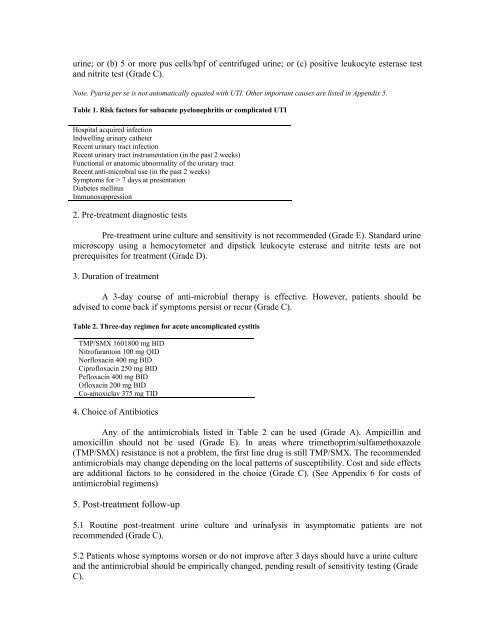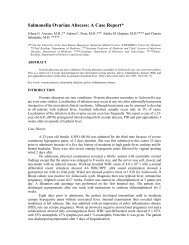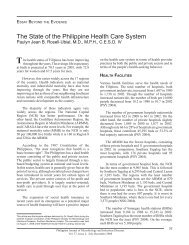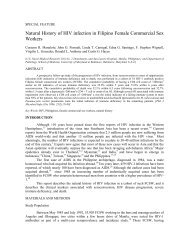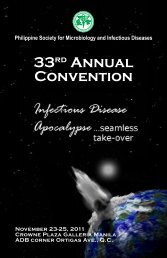The Philippine Clinical Practice Guideline on the Diagnosis and ...
The Philippine Clinical Practice Guideline on the Diagnosis and ...
The Philippine Clinical Practice Guideline on the Diagnosis and ...
Create successful ePaper yourself
Turn your PDF publications into a flip-book with our unique Google optimized e-Paper software.
urine; or (b) 5 or more pus cells/hpf of centrifuged urine; or (c) positive leukocyte esterase test<br />
<strong>and</strong> nitrite test (Grade C).<br />
Note. Pyuria per se is not automatically equated with UTI. O<strong>the</strong>r important causes are listed in Appendix 5.<br />
Table 1. Risk factors for subacute pyel<strong>on</strong>ephritis or complicated UTI<br />
Hospital acquired infecti<strong>on</strong><br />
Indwelling urinary ca<strong>the</strong>ter<br />
Recent urinary tract infecti<strong>on</strong><br />
Recent urinary tract instrumentati<strong>on</strong> (in <strong>the</strong> past 2 weeks)<br />
Functi<strong>on</strong>al or anatomic abnormality of <strong>the</strong> urinary tract<br />
Recent anti-microbial use (in <strong>the</strong> past 2 weeks)<br />
Symptoms for > 7 days at presentati<strong>on</strong><br />
Diabetes mellitus<br />
Immunosuppressi<strong>on</strong><br />
2. Pre-treatment diagnostic tests<br />
Pre-treatment urine culture <strong>and</strong> sensitivity is not recommended (Grade E). St<strong>and</strong>ard urine<br />
microscopy using a hemocytometer <strong>and</strong> dipstick leukocyte esterase <strong>and</strong> nitrite tests are not<br />
prerequisites for treatment (Grade D).<br />
3. Durati<strong>on</strong> of treatment<br />
A 3-day course of anti-microbial <strong>the</strong>rapy is effective. However, patients should be<br />
advised to come back if symptoms persist or recur (Grade C).<br />
Table 2. Three-day regimen for acute uncomplicated cystitis<br />
TMP/SMX 1601800 mg BID<br />
Nitrofurantoin 100 mg QID<br />
Norfloxacin 400 mg BID<br />
Ciprofloxacin 250 mg BID<br />
Pefloxacin 400 mg BID<br />
Ofloxacin 200 mg BID<br />
Co-amoxiclav 375 mg TID<br />
4. Choice of Antibiotics<br />
Any of <strong>the</strong> antimicrobials listed in Table 2 can he used (Grade A). Ampicillin <strong>and</strong><br />
amoxicillin should not be used (Grade E). In areas where trimethoprim/sulfamethoxazole<br />
(TMP/SMX) resistance is not a problem, <strong>the</strong> first line drug is still TMP/SMX. <str<strong>on</strong>g>The</str<strong>on</strong>g> recommended<br />
antimicrobials may change depending <strong>on</strong> <strong>the</strong> local patterns of susceptibility. Cost <strong>and</strong> side effects<br />
are additi<strong>on</strong>al factors to he c<strong>on</strong>sidered in <strong>the</strong> choice (Grade C). (See Appendix 6 for costs of<br />
antimicrobial regimens)<br />
5. Post-treatment follow-up<br />
5.1 Routine post-treatment urine culture <strong>and</strong> urinalysis in asymptomatic patients are not<br />
recommended (Grade C).<br />
5.2 Patients whose symptoms worsen or do not improve after 3 days should have a urine culture<br />
<strong>and</strong> <strong>the</strong> antimicrobial should be empirically changed, pending result of sensitivity testing (Grade<br />
C).


